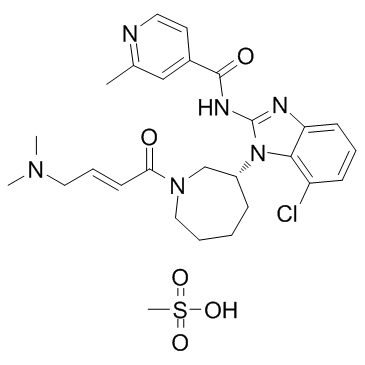
EGF816 mesylate
CAS No. 1508250-72-3
EGF816 mesylate( EGF-816 mesylate | Nazartinib mesylate )
Catalog No. M12106 CAS No. 1508250-72-3
EGF816 (Nazartinib) is a potent, irreversible, mutant-selective EGFR inhibitor with Ki and Kinact of 31 nM and 0.222 min-1, respectively.
Purity : >98% (HPLC)
 COA
COA
 Datasheet
Datasheet
 HNMR
HNMR
 HPLC
HPLC
 MSDS
MSDS
 Handing Instructions
Handing Instructions
| Size | Price / USD | Stock | Quantity |
| 5MG | 873 | Get Quote |


|
| 50MG | 1782 | Get Quote |


|
| 100MG | 2250 | Get Quote |


|
| 200MG | Get Quote | Get Quote |


|
| 500MG | Get Quote | Get Quote |


|
| 1G | Get Quote | Get Quote |


|
Biological Information
-
Product NameEGF816 mesylate
-
NoteResearch use only, not for human use.
-
Brief DescriptionEGF816 (Nazartinib) is a potent, irreversible, mutant-selective EGFR inhibitor with Ki and Kinact of 31 nM and 0.222 min-1, respectively.
-
DescriptionEGF816 (Nazartinib) is a potent, irreversible, mutant-selective EGFR inhibitor with Ki and Kinact of 31 nM and 0.222 min-1, respectively; shows potent inhibition of pEGFR levels in H3255, HCC827, and H1975 with EC50 of 5, 1, and 3 nM, which harbor the L858R, Ex19del, and L858R/T790M mutations, respectively, inhibitscell proliferation with EC50 of 9, 11, and 25 nM, but not the WT EGFR-containing patient-derived cell lines; potently inhibits the most common EGFR mutations L858R, Ex19del, and T790M in vitro; causes tumor regressions in vivo in several patient-derived xenograft models, also demonstrates antitumor activity in exon 20 insertion mutant model.Lung Cancer Phase 3 Clinical.
-
In VitroNazartinib (EGF816) has inhibitory effect on the mutant cell lines with IC50s of 4, 6, 2 nM in H1975, H3255, and HCC827, respectively, and demonstrates improved ADME and PK properties. Nazartinib (EGF816) shows potent inhibition of pEGFR levels in H3255, HCC827, and H1975 cell lines with EC50 values of 5, 1, and 3 nM, respectively. Nazartinib inhibits cell proliferation, with EC50 values of 9, 11, and 25 nM in H3255, HCC827, and H1975, respectively. Nazartinib has an OC50 (compound concentration at 50% occupancy) value of 2 and 5 nM on HCC827 and H1975, respectively.
-
In VivoIn H1975 mouse xenograft model, Nazartinib (EGF816; 50 and 20 mg/kg or 25 mg/kg, p.o.) demonstrates dose-dependent efficacy with near complete tumor cells regression at the highest dose tested (50 mg/kg). In H1975 mouse model, Nazartinib (EGF816; 10 mg/kg, p.o.) induces tumor growth inhibition with a T/C (tumor/control volume) of 29%, and when doses are 30 and 100 mg/kg, tumor regressions are achieved (T/C, ?61% and ?80%, respectively). In the H3255 xenograft model, Nazartinib (30 mg/kg, p.o.) shows significant antitumor activity. Antiproliferative activity of Nazartinib on 89 lung cancer cell lines indicates that Nazartinib selectively inhibits cell lines containing EGFR with catalytic domain mutations.
-
SynonymsEGF-816 mesylate | Nazartinib mesylate
-
PathwayAngiogenesis
-
TargetEGFR
-
RecptorEGFR
-
Research AreaCancer
-
IndicationLung Cancer
Chemical Information
-
CAS Number1508250-72-3
-
Formula Weight591.122
-
Molecular FormulaC27H35ClN6O5S
-
Purity>98% (HPLC)
-
Solubility10 mM in DMSO
-
SMILESCC1=NC=CC(=C1)C(=O)NC2=NC3=C(N2C4CCCCN(C4)C(=O)C=CCN(C)C)C(=CC=C3)Cl.CS(=O)(=O)O
-
Chemical Name4-Pyridinecarboxamide, N-[7-chloro-1-[(3R)-1-[(2E)-4-(dimethylamino)-1-oxo-2-buten-1-yl]hexahydro-1H-azepin-3-yl]-1H-benzimidazol-2-yl]-2-methyl-, methanesulfonate (1:1)
Shipping & Storage Information
-
Storage(-20℃)
-
ShippingWith Ice Pack
-
Stability≥ 2 years
Reference



-
Avitinib maleate
Avitinib maleate (AC-0010MA, AC0010 maleate) is an?orally available, irreversible, and mutant-selective EGFR inhibitor with IC50 of 0.18 nM against EGFR L858R/T790M.
-
Poziotinib hydrochlo...
Poziotinib hydrochloride irreversibly inhibits EGFR (HER1 or ErbB1), including EGFR mutants, HER2, and HER4, thereby inhibiting the proliferation of tumor cells that overexpress these receptors.?It is an orally bioavailable, quinazoline-based pan epidermal growth factor receptor (EGFR or HER) inhibitor with potential antineoplastic activity.?
-
Dacomitinib hydrate
Dacomitinib hydrate is a highly selective and second-generation small-molecule inhibitor of the pan-epidermal growth factor receptor family of tyrosine kinases.



 Cart
Cart
 sales@molnova.com
sales@molnova.com


